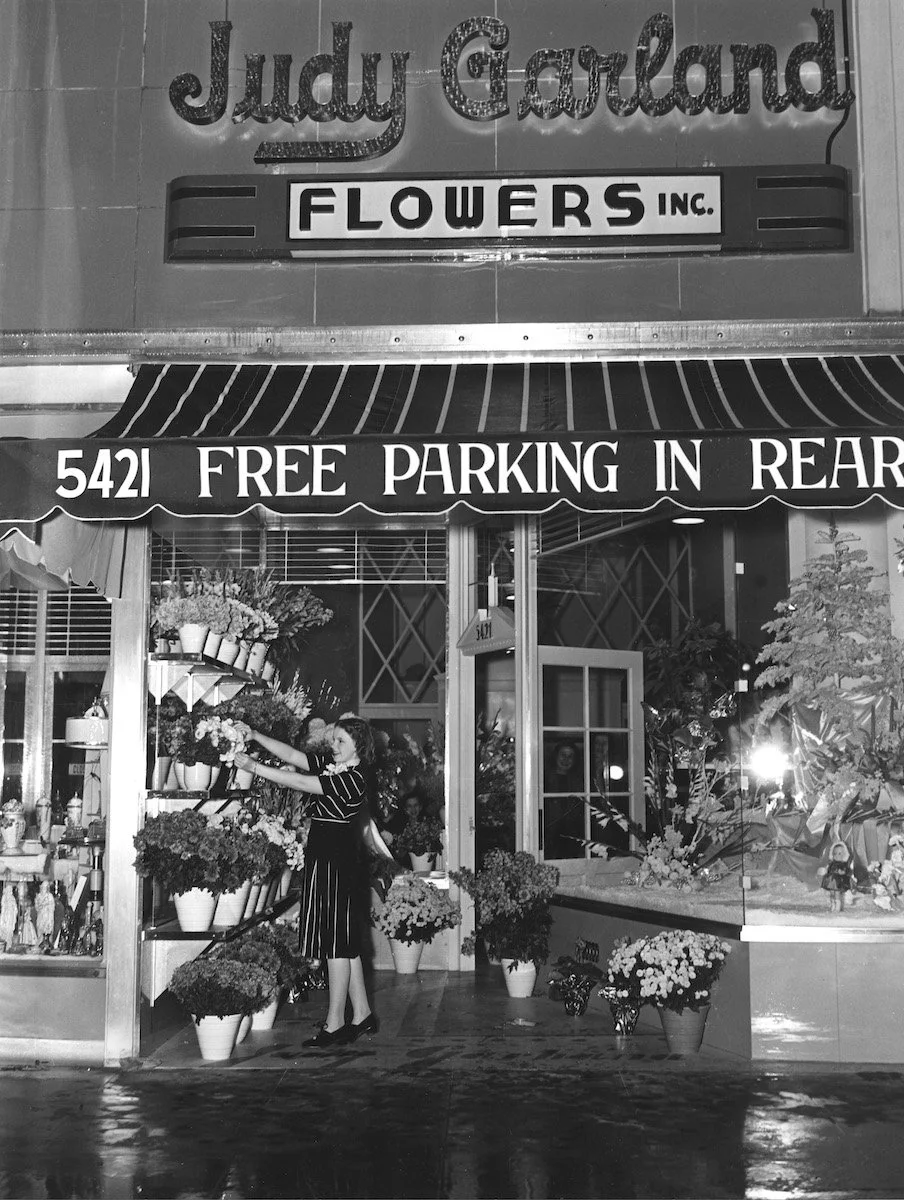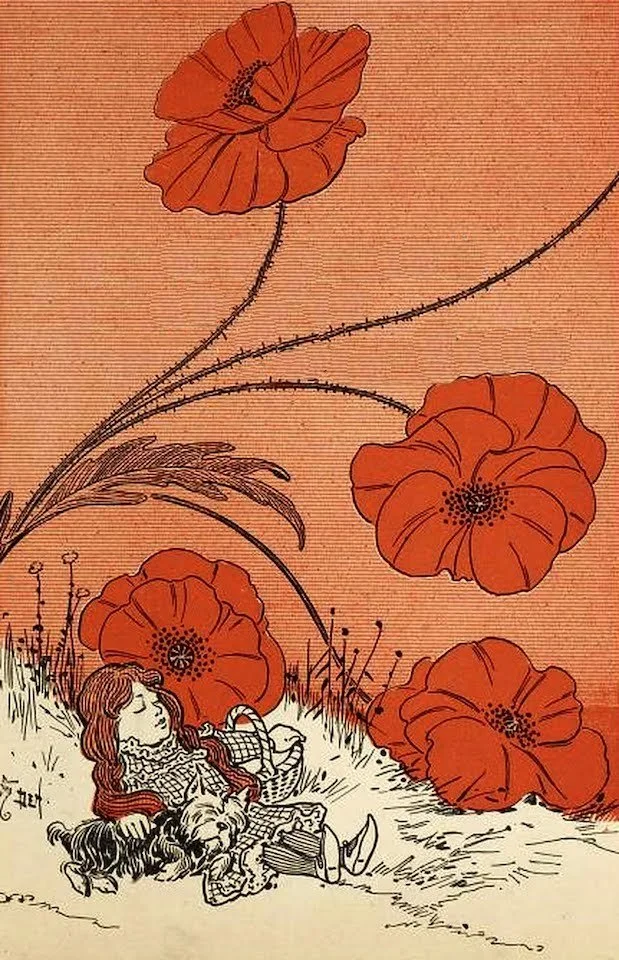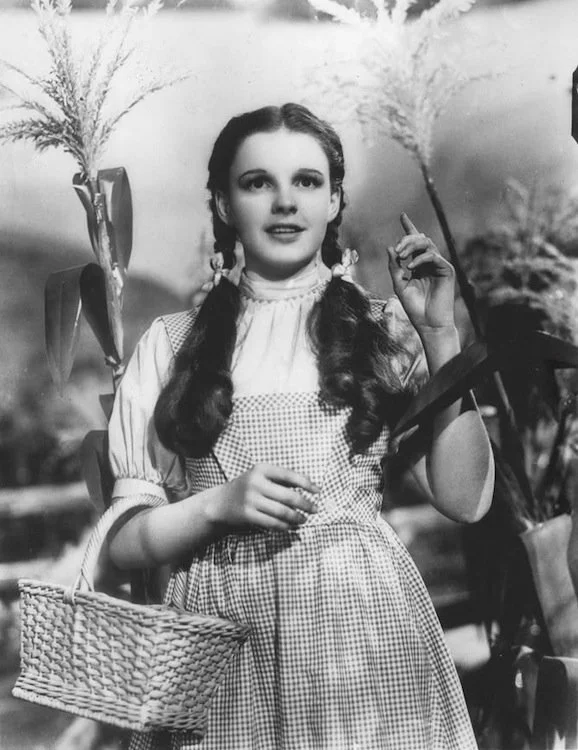Image credit: Everett Collection
Magical Poppies,
Giant Hollyhocks,
& Blossoming Garlands
Judy Garland’s Flower Shop & Blooming Motifs in The Wizard of Oz
FLORALS ON FILM
Disclosure: Superbloom may earn revenue via affiliate marketing commissions for some of the products we link to—though you’ll never pay more for them because of that. See our full disclaimers and disclosures for more information about the affiliate programs in which we participate.
Image credit: Everett Collection
When thinking of the flowers in the story of Dorothy’s journey through the dreamland of Oz, poppies are likely the first blooms that come to mind, though there’s so much more to the tangle of flowers within – and surrounding – the story.
Perhaps most surprising is that Judy Garland was herself a florist and owned her own flower shop at the age of 15. In efforts to ensure her daughter had a more-stable backup plan in case the whole showbiz path didn’t work out, Judy Garland’s mother co-signed a lease on a flower shop with her daughter, with earnings going into a trust fund for the future.
Set alongside the shops of Wilshire Blvd, Judy Garland Flowers, Inc., catered to a clientele in the Miracle Mile and Park La Brea neighborhoods in Los Angeles. Judy arranged flowers for orders, created boutonnieres, and designed displays of blooms in front of the shop – often after a full day of filming on the set of The Wizard of Oz.
Stories have drifted around about the floral shop being a part of a publicity stunt for the film (especially since MGM reportedly had a $250k promotional budget for the movie), but it’s more fun to picture Judy arranging blooms in her off hours. The Miracle Mile Residential Association documented the original storefront with a photo from the collection of the Los Angeles Public Library, so we’re choosing to believe, even if there’s a bit of magical thinking involved with her real-life pursuits.
Image credit: The Wonderful Wizard of Oz by L. Frank Baum, illustrated by W. W. Denslow, public domain, Library of Congress, Rare Book and Special Collections Division
In the original book The Wonderful Wizard of Oz by L. Frank Baum, the alluring yet deadly poppies (Papaver somniferum) that our protagonist Dorothy Gale encounters are described alongside fields of other gorgeous flowers, but they stand out because of the hold they have on anyone in their midst:
They walked along listening to the singing of the brightly colored birds and looking at the lovely flowers which now became so thick that the ground was carpeted with them. There were big yellow and white and blue and purple blossoms, besides great clusters of scarlet poppies, which were so brilliant in color they almost dazzled Dorothy's eyes.
"Aren't they beautiful?" the girl asked, as she breathed in the spicy scent of the bright flowers.
"I suppose so," answered the Scarecrow. "When I have brains, I shall probably like them better."
"If I only had a heart, I should love them," added the Tin Woodman.
"I always did like flowers," said the Lion. "They seem so helpless and frail. But there are none in the forest so bright as these."
They now came upon more and more of the big scarlet poppies, and fewer and fewer of the other flowers; and soon they found themselves in the midst of a great meadow of poppies. Now it is well known that when there are many of these flowers together their odor is so powerful that anyone who breathes it falls asleep, and if the sleeper is not carried away from the scent of the flowers, he sleeps on and on forever. But Dorothy did not know this, nor could she get away from the bright red flowers that were everywhere about; so presently her eyes grew heavy and she felt she must sit down to rest and to sleep.
In the 1939 MGM-produced film The Wizard of Oz, Dorothy and her friends run through billowing fields blanketed with scarlet poppies leading up to the Emerald City, their ultimate destination on their journey through Oz.
Under the spell of the enchanting pink and red poppies, Dorothy and the Cowardly Lion are lulled into a deep sleep after the Wicked Witch of the West casts a spell to try to stop her journey, eager to get her hands on the ruby slippers.
While the Scarecrow and Tin Man try to warn and then save them, it’s only a counter spell of a magical snowfall from Glinda the Good Witch that breaks the hold the poppies have over them.
The iconic Technicolor poppy scene in the 1939 film version of The Wizard of Oz was both a novel approach and resulted in the most expensive production to date. The field of poppies on the set was actually filled with paper flowers created by the production design team, and it might just have been the first superbloom captured on film. While it wasn’t a naturally occurring one, the spirit of the endless pink and red poppies in the movie absolutely evoke a superbloom, with a vibrant panorama of flowers overwhelming the senses and painting the hillsides.
Image credit: Everett Collection
"And now my beauties, something with poison in it I think, with poison in it, but attractive to the eye and soothing to the smell . . . poppies, poppies, poppies will put them to sleep."
—The Wicked Witch of the West
Image credit: Nick Fewings @jannerboy62, via Unsplash
Flowers played an even earlier role in Judy’s life as well. Born in 1922 as Frances Ethel Gumm, she and her two sisters performed as a vaudeville act and renamed themselves the Garland Sisters in 1934. There are multiple theories around about the origin of the name, though Judy’s daughter Lorna Luft shared in her 1999 memoir that her mother chose it after the actor George Jessel said that the trio "looked prettier than a garland of flowers.”
Upon winning the role of Dorothy Gale in the production of The Wizard of Oz (Shirley Temple having been unavailable), Judy was again surrounded by flowers on a daily basis, be they real ones or just constructed for the set. While it’s unclear what the native flora is in the county of Oz, flowers in general play a significant thematic role from the moment Dorothy awakes and finds herself there.
Salman Rushdie has written about the film’s influence on the concept of journeys and idea of “home” through the lens of his own childhood, and while much has been made about allegorical aspects of the story and the symbolism in Baum’s original book, this take is definitely a rose-colored-glasses one, so we’re sticking to the spectacle of its blossoms and botanicals here. The story’s possible meanings and lessons have been debated through a number of different angles, but what can’t be denied is the film’s groundbreaking use of color, saturation, scale, and design—and its botanical storytelling does an excellent job of both supporting the narrative and toeing the line between reality and fantasy.
Image credit: CBS Television Network, Public domain, via Wikimedia Commons
Demarcating the first real-life and dreamland aspects of the story is the vividly colored world Dorothy finds herself in once her Midwestern tornado fizzles out and drops her house back to the ground. Back in Kansas, wandering through gardens meant punishment, as Dorothy complained to Auntie Em that her dog Toto was hit with a rake by Miss Elvira Gulch for wandering through her garden and chasing a cat.
The opposite is true once Dorothy is dropped into dreamland, as a hyper-realistic-color version of nature is just waiting for her to begin exploring. Stepping outside its door, her first sights are of a land filled with vibrant, oversize blooms. The scene is set with giant hollyhocks, a symbol of happiness and abundance in many cultures, growing taller than the homes. Rambling yellow and apricot hibiscus also frame the initial shots as Dorothy looks around in awe and then utters the classic line: “Toto, I don’t think we’re in Kansas anymore.”
We’ll give her that, as the poor girl seems to have been permanently stuck on that one sepia-toned farm for years, without a daytrip in sight. But there’s likely not a radical disparity for other Kansans – especially those who frequent the various botanical gardens around their own state.
Image credit: Warner Bros., Public domain, via Wikimedia Commons
(Side note to bookmark: the much-beloved Overland Park Arboretum & Botanical Gardens are a must-stop if your own return from Oz lands you out that way, as it features an enchanted forest, its own babbling brook, fairy houses, and bountiful gardens filled with dogwoods, zinnias, giant hostas, paw-paw ferns, native wildflowers, and more than 300 varieties of irises.)

Framing her scene with Glinda, the Good Witch of the North, are big, bright daisies that surround the entrance to the bridge. Upon Glinda’s assurance that all is safe, as it seems neither Dorothy or Toto is any kind of witch, the inhabitants of this whacked-out and wonderful flowery land emerge from their hiding places in the saturated, oversized blooms. Violets, peonies, and roses adorn their hats and clothing, further cementing the idea that perhaps an abundance of joyful flowers (plus quite a bit of song and dance!) are the essence of this land.
While we can still appreciate the fantastical production of it all, it turns out the gargantuan blossoms served a practical purpose, too:
“Like most films of the 1930s, the Wizard of Oz was shot on sets constructed in the MGM studio in Hollywood. Because the set was so large, as many as nine cameras hidden in bushes or potted plants would be used to film one scene. The hidden cameras took close-ups, while the main camera, used to capture the whole scene, was on the end of a boom and was constantly moving.”
-from the Library of Congress
As Dorothy wanders around, wide-eyed and curious, she ends up on an island with a giant tulip hanging over it, surrounded by lily pads floating all around and colorful banks of blossoms and ferns decorating the stream running through town.
Just as the Wicked Witch of the West shows up to unleash her wrath, Dorothy is seen holding a posy bouquet of carnations, marigolds, and tiny bluebells. This gift was a sweet gesture bestowed on Dorothy by the town, though it was likely not just a “Welcome, new friend!” gift as much as it was a token of gratitude for her unplanned service. Dropping a house on the Wicked Witch of the East was a joyous occasion for them, as she’d likely been a major vibe-killer who terrorized them repeatedly, and given that Glinda was assuredly *not* on board with her scene, either, it’s hard to feel too bad about this demise.
As the villagers then see Dorothy off, rows of white daisies frame the portion of the Yellow Brick Road that leads out of town. For centuries, white daisies have symbolized innocence, new beginnings, and hope, and they set the tone as our girl D heads out alone on her hero’s journey to hopefully find someone who can help her get back home. It’s definitely not a surprise that no one in town chooses to accompany her, though, as the endless cornfields ahead don’t seem quite as cheerful as the cute gardens and swirly roads of downtown.
But Dorothy soon finds a kindred spirit in the Scarecrow who, like her, shares in his famous song that he has a tendency to “while away the hours, conferrin’ with the flowers.” Though they both can be dreamers, it’s only because they know there’s more out there to explore and experience, an escape that’s somewhere over the rainbow. There’s a whole realm of meaning here that’s even been dissected in law-school whitepapers, but again, let’s leave that deep dive to the academics – especially since many of us are in life stages where conferrin’ with the flowers doesn’t really sound like that bad of an existence.
From that point on, Dorothy still has her small bouquet of flowers, and we won’t question how they lasted along the journey since magical lands can do things like that. After the dramatic poppy field debacle, we see more flowers setting the tone in the movie, when she finally arrives at her destination: the Emerald City. The local businesses and salon in Oz give Dorothy and her pals a serious glow-up—one that’s likely much-needed after traipsing across fields and cowering in deep, dark forests. Everyone gets groomed, stuffed, and polished in anticipation of meeting with the great and powerful Oz himself.
Image credit: Everett Collection
The moment truly belongs to the Cowardly Lion, though—after his lovely tresses are combed, set, and tied with a bow, the group is happily gathering together again when the Wicked Witch shows back up again. The smoke from her broom creates chaos as she writes “SURRENDER DOROTHY” across the sky, prompting them to remind the Guard (slash Wizard) that they’ve come with an appointment in mind, and stat. In their excitement about what their meeting might bring for the next phases of their lives, the Cowardly Lion decides to call his own number and belt out a solo. Set in what we’ll just assume are the indoor botanical gardens of the Emerald City, the dominant shades of green appear not just in the set decor, but also in the stems and leaves throughout the backdrop of his song.

Set amidst hundreds of yellow roses, which have long been associated with friendship in Western cultures, the foursome play and sing together for the last musical number of the film, their journey having bonded them.
A cracked flower pot is turned upside down to rest on the Cowardly Lion’s head like a crown, and what looks like a rug is pulled up to serve as a cape. Made of dark green velvet, it’s edged all around with tufts of white blossoms. The makeshift rug-turned-cape does its job during the Lion’s scene as make-believe royalty in the forest, accenting his pomp and circumstance with a botanical bent.
These floral-filled fantasies remain only in the Technicolor-Oz-version of the story, as the penultimate scene leads to our dear Dorothy realizing that, as Dolly Parton has sung, “The magic is inside you, there ain’t no crystal ball.” After making her wish and tapping her slippers, Dorothy is returned to the sepia-toned version of Kansas.
While her sentiment “If I ever go looking for my heart's desire again, I won't look any further than my own backyard” might seem a bit limiting for a girl who clearly has an adventurous spirit, we can dream a bit more here and hope that it at least resulted in Dorothy planting her own garden, a place to wander and run through with Toto whenever she pleased.
Image credit: Hyeonhui Kim @crisp_yworks
Image credit: Krzysztof Ziarnek, Kenraiz, CC BY-SA 4.0, via Wikimedia Commons
More tidbits about the flowers in Oz and in Judy Garland’s life
Coincidentally, the name of Judy’s first husband was David Rose – a moniker evoking a theme that would run throughout her life.
A chorus line of poppies acted in the 1903 stage version of the play, and the alluring flowers have been represented that way in several other versions, including the 1978 Quincy Jones–produced film The Wiz, starring Diana Ross as Dorothy. Called the Poppy Girls, the dancers inhabit an alley near Poppy Perfume Co., and have fabulously sparkly crimson, fuschia, and orange spandex-y costumes covered in silk poppies. Their sedative is a mix of glitter and perfume, an understandably appealing combo.
In 1963, Judy wore a dress covered in poppies that was designed by Ray Aghayan, inspired by the famous scene in the film. She then wore the dress several times throughout the 1960s, as an homage to her role as Dorothy.
In 1978, a fragrant floribunda rose named Judy Garland was introduced. Blooming heavily, the yellow and red-tinged petals evoke the swirls of the beginning of the Yellow Brick Road.
Judy’s daughters Liza Minnelli and Lorna Luft planted 1000 Judy Garland Roses for the occasion of what would have been their mother’s 100th birthday in June 2022. The event occurred in tandem with the launch of a perfume called “Judy” that they created to commemorate her life and legacy, with the heady fragrance of the Judy Garland floribunda rose mixed with notes of dark orchid, bourbon, and lily-of-the-valley. The fragrance is all-inclusive and gender-neutral, as Judy was an activist for the queer community (and coincidentally, passed on the same day of the Stonewall Riots) as well as a supporter of the Civil Rights Movement.
Fields of poppies & Technicolor florals…
We respect your privacy, and when you click “Sign Up,” you are confirming that you agree that information you submit will be protected and used as permitted in our privacy policy and terms. If you do not agree to any of these terms, you may not submit this form.


















